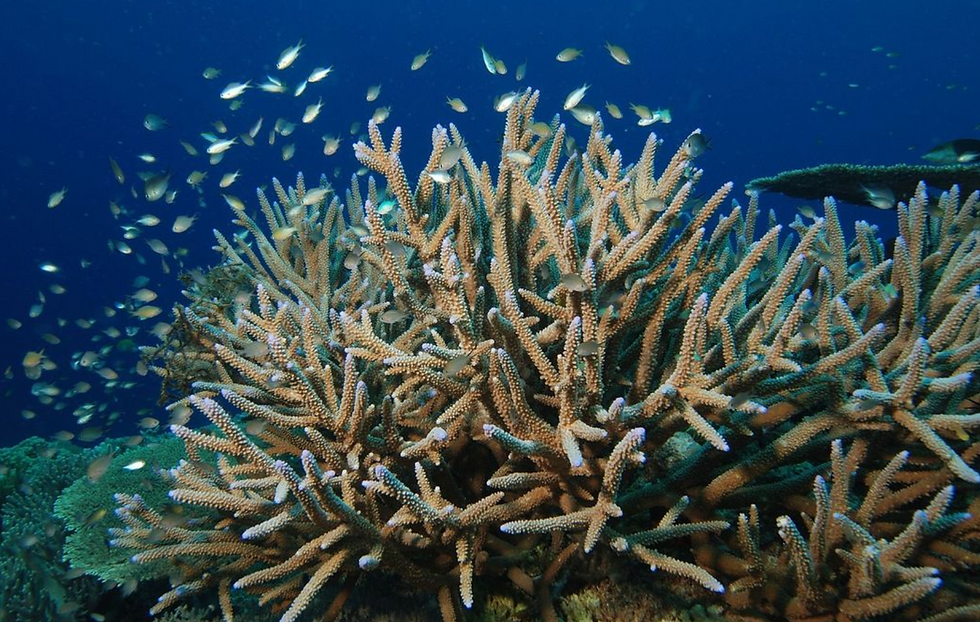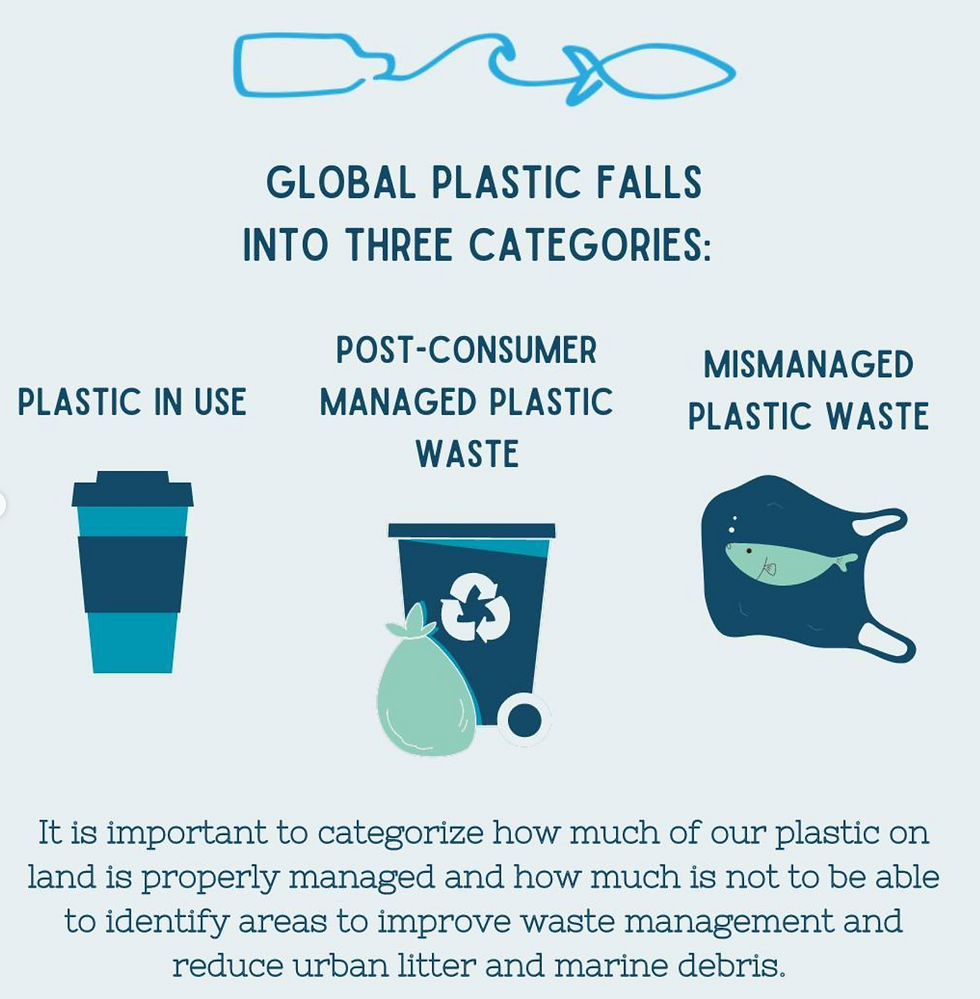May 2023 Research Summaries and Sustainability Tips
- keeptheoceaneverblue
- Jun 1, 2023
- 5 min read
May this month's research and sustainability tips inspire you!

MAY 3: RESEARCH SUMMARY - STUDYING FISH FLIGHT
Brand-new research published last week shows that fish like groupers, snappers, grunts, and emperors on a reef show avoidance behavior to both potential predators and snorkelers. The researchers used a remote underwater stereo-video system to measure the distance and speed that fish swam away from threatening snorkelers and model sharks as well as non-threatening models of turtles and research gear. The fish were unbothered by the non-threatening models, but stayed far away from the shark models and the snorkelers.
The researchers also found that there was no difference between the distance of avoidance behavior between the model shark and snorkelers, which means they were perceived as equally threatening by the fishes.
MAY 5: SUSTAINABILITY TIP - BE A SMART SNORKELER
We know from research published last week that fish avoid snorkelers in a similar manner to how they avoid sharks, and also that this behavior can reduce their ability to find food and mates since they’re spending energy on avoiding potential predators.

To help fish and make sure we’re affecting their behavior as little as possible, when you go snorkeling remember to be a respectful visitor to the reef! Swim with slow movements and try to avoid big splashing to observe but not disturb. You can also practice being a safe snorkeler by staying horizontal and not standing on the reef or rocks and not touching any part of the reef. This won’t remove all effects on the reef community, as just our presence alone causes fishes to change their behavior, but it can help reduce unnecessary stress.
MAY 10: RESEARCH SUMMARY - SHIFTING SANDS
In this recent study, researchers looked at the effects different types of human activities have on the environment, including sand mining. Current sand extraction is happening at a rate faster than nature can renew sand stock. This causes instability in coastal ecosystems, resulting in problems such as erosion, habitat destruction, and loss of marine biodiversity. The addition of marine protected shoreline areas and increased regulations for sand mining would foster the preservation of these important resources and habitats.
MAY 12: SUSTAINABILITY TIP - STABILIZING SAND DUNES
Are you wondering what you can do about coastal erosion? Look out for volunteer conservation events in your area! Many nonprofits and scientific organizations host volunteer events where you can do your part to protect and preserve our environment.

For example, team member Sibly attended a sand dune stabilization event hosted by The National Aquarium in May, where volunteers worked with restoration specialists to stabilize sand dunes against erosion on the east coast. Sand dunes are an important part of coastal ecology - they provide protection from storm surges and wave activity, reduce coastal flooding (a growing problem as the seas rise,) and are habitats to many coastal animals.
Can’t make a volunteer event but still want to help out? Donate $1 to a conservation organization for every event you’d like to attend! It adds up, and that money is super important for obtaining the tools and resources necessary to sufficiently protect and restore our environment.
MAY 17: RESEARCH SUMMARY - CORAL CHECK-IN
Reef experts and authorities at the Great Barrier Reef have been “in a near-constant state of damage control” since 2016. In the last few decades, marine heatwaves, pollution, and a coral-eating starfish have been ravaging the reef and in 2020 a study found that roughly half of the Great Barrier Reef’s corals had disappeared over the last few decades. After a series of massive marine heatwaves in early 2022, the fever broke and opened a brief but important window for some species of coral to reclaim the area.

This is great news, but scientists are still wary of the reef's future. Monitoring programs show that most of the coral returning is a weedy genus of fast-growing corals (Acropora). These include species such as staghorn, elkhorn, and tabletop corals, and while they may be prolific, they are fragile and easily destroyed by storms that are already becoming more frequent. They’re also a favorite food of those coral eating starfish we mentioned above.
“Instead of a diverse, old-growth forest, [the reef] may now be like a monoculture of planted pulp trees,” says WHOI’s Konrad Hughen.
Regardless, scientists still consider this a good sign. This result suggests that with even one less pressure, the reefs can recover. Despite their recent setbacks, coral demonstrates remarkable resiliency. “The point is that reefs are resilient and they’re always recovering, even if not fully recovered,” Hughen emphasized. “The question is whether we’re going to keep impacting and damaging them faster than they can come back.”
MAY 19: SUSTAINABILITY TIP - HELPING OUR REEFS
The problems being faced by coral reefs around the world are major and probably cannot be addressed by individual actions. That being said, there are still a few ways you can protect the reefs you visit!
Choose sustainable seafood using tools like FishWatch.gov.
If you visit a reef, make sure not to touch it! Coral are living creatures. Even kicking up sediment can cover corals.
Practice safe boating: make sure to anchor in sandy areas away from coral to avoid dragging the anchor and chain through them.
Check to make sure your sunscreen doesn’t contain chemicals that harm coral! We’ve talked about this before here at Everblue, but the list is easier found through an internet search or by visiting oceanservice.noaa.gov/sunscreen
MAY 25: RESEARCH SUMMARY - PLASTIC PATHWAYS
How much plastic waste is actually mismanaged (mismanaged plastic waste or MPW), and where does it go?

A study from 2019 used data on countries’ waste generation to estimate that in 2015, between 60-99 million metric tonnes of MPW were produced globally. Based on population growth, the study predicts that this could grow to 155-265 million metric tonnes by 2060.
How can we curb the increase of global MPW in the next 40 years? Investing in waste management infrastructure and focusing on cleaning rivers (which can transport up to 91% of MPW) is important to reduce the amount of plastic that gets mismanaged.
MAY 26: SUSTAINABILITY TIP - TREATY TALKS
On this upcoming Monday, May 29, international plastics treaty talks are starting in Paris - watch this video from The Story of Stuff Project to learn more:
But what do we need in a global plastics treaty? The video notes that we need a commitment to:
Cutting plastic production, stopping pollution at the source
Advancing environmental justice to provide for workers along the plastic supply chain and protect those who are at risk from plastic pollution
Rejecting false solutions created by companies that want to maintain the status quo of unsustainable plastics manufacturing
To call for these actions and support a strong and legally binding plastics treaty for nations of the world, visit this link to sign the petition!





Comments